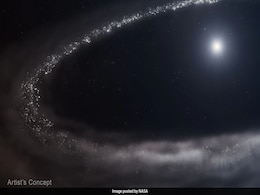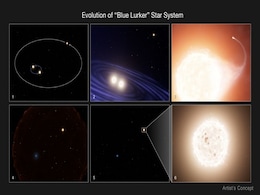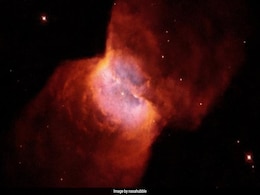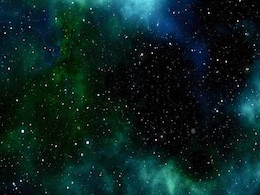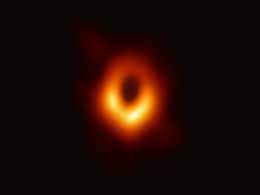Sun-like Star
- All
- News
-

James Webb Telescope Detects Frozen Water In Young Star System For The First Time
- Tuesday June 3, 2025
- Science | Edited by Ritu Singh
This finding has opened up new avenues for understanding the early universe and the origins of water on our planet
-
 www.ndtv.com
www.ndtv.com
-

NASA's James Webb Telescope Spots Frozen Water In Distant Star System For The First Time
- Thursday May 22, 2025
- Science | Edited by Abhinav Singh
Crystalline water ice has been found in a dusty debris disk that orbits a Sun-like star, only 23 million years old, 155 light-years away.
-
 www.ndtv.com
www.ndtv.com
-

NASA’s Hubble Observes Rare Blue Lurker Star with Unusual Evolution in M67 Cluster
- Friday January 17, 2025
- Written by Gadgets 360 Staff
NASA’s Hubble Space Telescope has identified a rare stellar phenomenon called the “blue lurker” in the M67 star cluster. Located 2,800 light-years away, this star is part of a triple-star system and has an unusual evolutionary history. The blue lurker’s accelerated spin, taking just four days, contrasts with the typical rotation of Sun-like...
-
 www.gadgets360.com
www.gadgets360.com
-

Indian Scientists Discover A Massive Exoplanet That is Five Times Larger Than Earth
- Tuesday October 29, 2024
- Written by Gadgets 360 Staff
Indian scientists have identified a new exoplanet named TOI-6651b, which is five times larger than Earth and has a mass around 60 times greater. Located in the Neptunian desert, it orbits a Sun-like star every 5.06 days. The planet's composition suggests unique evolutionary processes, providing valuable insights into how such dense exoplanets form ...
-
 www.gadgets360.com
www.gadgets360.com
-

NASA Captures Stunning 'Cosmic Jewellery' 15,000 Light Years From Earth
- Thursday March 14, 2024
- Offbeat | Edited by Rahul Kumar
NASA explained that the Necklace Nebula was formed by a duo of aging Sun-like stars in close orbit. Initially, one of the aging stars expanded and swallowed its smaller companion.
-
 www.ndtv.com
www.ndtv.com
-

NASA's Hubble Telescope Captures "Last Gasp" Of Dying Binary Star System
- Thursday February 22, 2024
- Science | Edited by Anoushka Sharma
NGC 2346 is a so-called "planetary nebula," which is ejected from Sun-like stars which are near the ends of their lives.
-
 www.ndtv.com
www.ndtv.com
-

In Search For Earth-Like Habitable Planets, Scientists Find A 6-Pack Orbiting Sun-Like Star
- Thursday November 30, 2023
- Science | Edited by Amit Chaturvedi
The discovery made the news because of the unusual nature of the planets, which are locked into a resonance with one another.
-
 www.ndtv.com
www.ndtv.com
-

Study Finds Continents In Milky Way That Are Older Than Earth's
- Wednesday November 15, 2023
- Science | Edited by Amit Chaturvedi
The research found that first continents formed around nearby Sun-like stars at least 5 billion years earlier than Earth's plate tectonics began.
-
 www.ndtv.com
www.ndtv.com
-

NASA's James Webb Telescope Captures Stunning Shot Of A Newborn Sun-Like Star
- Saturday September 16, 2023
- Science | Edited by Ritu Singh
The rare image features jets of star matter blasting from the poles of a very young star and zipping through space at supersonic speeds.
-
 www.ndtv.com
www.ndtv.com
-

Supermassive Black Hole Spotted Eating Sun-Like Star in Nearby Galaxy
- Saturday September 9, 2023
- Reuters
Black holes, celestial objects known for their gluttony, usually eat stars unlucky enough to stray too close to them in one big gulp, annihilating them with their enormous gravitational pull. But some, it turns out, tend to snack rather than gorge. Researchers said they have observed a supermassive black hole at the center of a relatively nearby ga...
-
 www.gadgets360.com
www.gadgets360.com
-

Sun-Like Star "Repeatedly Shredded, Consumed By Black Hole" Spotted By Astronomers
- Friday September 8, 2023
- Science | Edited by Amit Chaturvedi
The star, known as Swift J0230, follows an elliptical orbit around a low-mass black hole situated at the centre of its galaxy.
-
 www.ndtv.com
www.ndtv.com
-

NASA Shares Dazzling Shot Of Cosmic Necklace Located 15,000 Light Years Away
- Tuesday July 25, 2023
- Science | Edited by Ritu Singh
NASA took to Instagram to share a stunning picture of the "Necklace Nebula", which was created by a pair of tightly orbiting Sun-like stars.
-
 www.ndtv.com
www.ndtv.com
-

This Distant Star Has 2 'Earth-Sized' Habitable Planets Orbiting It
- Thursday March 9, 2023
- Science | The Conversation
Astronomers discovered the first exoplanet around a Sun-like star in 1995. The field of exoplanet discovery and research has been rapidly evolving ever since.
-
 www.ndtv.com
www.ndtv.com
-

NASA’s James Webb Telescope Detects Signs of Water on Distant ‘WASP-96 b’ Planet
- Wednesday July 13, 2022
- Press Trust of India
NASA's James Webb Space Telescope (JWST) detected signs of water and evidence of clouds and haze, in the atmosphere of WASP-96 b, located roughly 1,150 light-years away in the southern-sky constellation Phoenix, and one of more than 5,000 confirmed exoplanets in the Milky Way. The most detailed observation of its kind to date, it demonstrates Webb'...
-
 www.gadgets360.com
www.gadgets360.com
-

NASA's James Webb Telescope Detects Water On Distant Planet. Details Here
- Wednesday July 13, 2022
- Science | Press Trust of India
NASA's James Webb Space Telescope has detected signs of water, along with evidence for clouds and haze, in the atmosphere of a hot, puffy gas giant planet orbiting a Sun-like star over a thousand light years away, the US space agency said today.
-
 www.ndtv.com
www.ndtv.com
-

James Webb Telescope Detects Frozen Water In Young Star System For The First Time
- Tuesday June 3, 2025
- Science | Edited by Ritu Singh
This finding has opened up new avenues for understanding the early universe and the origins of water on our planet
-
 www.ndtv.com
www.ndtv.com
-

NASA's James Webb Telescope Spots Frozen Water In Distant Star System For The First Time
- Thursday May 22, 2025
- Science | Edited by Abhinav Singh
Crystalline water ice has been found in a dusty debris disk that orbits a Sun-like star, only 23 million years old, 155 light-years away.
-
 www.ndtv.com
www.ndtv.com
-

NASA’s Hubble Observes Rare Blue Lurker Star with Unusual Evolution in M67 Cluster
- Friday January 17, 2025
- Written by Gadgets 360 Staff
NASA’s Hubble Space Telescope has identified a rare stellar phenomenon called the “blue lurker” in the M67 star cluster. Located 2,800 light-years away, this star is part of a triple-star system and has an unusual evolutionary history. The blue lurker’s accelerated spin, taking just four days, contrasts with the typical rotation of Sun-like...
-
 www.gadgets360.com
www.gadgets360.com
-

Indian Scientists Discover A Massive Exoplanet That is Five Times Larger Than Earth
- Tuesday October 29, 2024
- Written by Gadgets 360 Staff
Indian scientists have identified a new exoplanet named TOI-6651b, which is five times larger than Earth and has a mass around 60 times greater. Located in the Neptunian desert, it orbits a Sun-like star every 5.06 days. The planet's composition suggests unique evolutionary processes, providing valuable insights into how such dense exoplanets form ...
-
 www.gadgets360.com
www.gadgets360.com
-

NASA Captures Stunning 'Cosmic Jewellery' 15,000 Light Years From Earth
- Thursday March 14, 2024
- Offbeat | Edited by Rahul Kumar
NASA explained that the Necklace Nebula was formed by a duo of aging Sun-like stars in close orbit. Initially, one of the aging stars expanded and swallowed its smaller companion.
-
 www.ndtv.com
www.ndtv.com
-

NASA's Hubble Telescope Captures "Last Gasp" Of Dying Binary Star System
- Thursday February 22, 2024
- Science | Edited by Anoushka Sharma
NGC 2346 is a so-called "planetary nebula," which is ejected from Sun-like stars which are near the ends of their lives.
-
 www.ndtv.com
www.ndtv.com
-

In Search For Earth-Like Habitable Planets, Scientists Find A 6-Pack Orbiting Sun-Like Star
- Thursday November 30, 2023
- Science | Edited by Amit Chaturvedi
The discovery made the news because of the unusual nature of the planets, which are locked into a resonance with one another.
-
 www.ndtv.com
www.ndtv.com
-

Study Finds Continents In Milky Way That Are Older Than Earth's
- Wednesday November 15, 2023
- Science | Edited by Amit Chaturvedi
The research found that first continents formed around nearby Sun-like stars at least 5 billion years earlier than Earth's plate tectonics began.
-
 www.ndtv.com
www.ndtv.com
-

NASA's James Webb Telescope Captures Stunning Shot Of A Newborn Sun-Like Star
- Saturday September 16, 2023
- Science | Edited by Ritu Singh
The rare image features jets of star matter blasting from the poles of a very young star and zipping through space at supersonic speeds.
-
 www.ndtv.com
www.ndtv.com
-

Supermassive Black Hole Spotted Eating Sun-Like Star in Nearby Galaxy
- Saturday September 9, 2023
- Reuters
Black holes, celestial objects known for their gluttony, usually eat stars unlucky enough to stray too close to them in one big gulp, annihilating them with their enormous gravitational pull. But some, it turns out, tend to snack rather than gorge. Researchers said they have observed a supermassive black hole at the center of a relatively nearby ga...
-
 www.gadgets360.com
www.gadgets360.com
-

Sun-Like Star "Repeatedly Shredded, Consumed By Black Hole" Spotted By Astronomers
- Friday September 8, 2023
- Science | Edited by Amit Chaturvedi
The star, known as Swift J0230, follows an elliptical orbit around a low-mass black hole situated at the centre of its galaxy.
-
 www.ndtv.com
www.ndtv.com
-

NASA Shares Dazzling Shot Of Cosmic Necklace Located 15,000 Light Years Away
- Tuesday July 25, 2023
- Science | Edited by Ritu Singh
NASA took to Instagram to share a stunning picture of the "Necklace Nebula", which was created by a pair of tightly orbiting Sun-like stars.
-
 www.ndtv.com
www.ndtv.com
-

This Distant Star Has 2 'Earth-Sized' Habitable Planets Orbiting It
- Thursday March 9, 2023
- Science | The Conversation
Astronomers discovered the first exoplanet around a Sun-like star in 1995. The field of exoplanet discovery and research has been rapidly evolving ever since.
-
 www.ndtv.com
www.ndtv.com
-

NASA’s James Webb Telescope Detects Signs of Water on Distant ‘WASP-96 b’ Planet
- Wednesday July 13, 2022
- Press Trust of India
NASA's James Webb Space Telescope (JWST) detected signs of water and evidence of clouds and haze, in the atmosphere of WASP-96 b, located roughly 1,150 light-years away in the southern-sky constellation Phoenix, and one of more than 5,000 confirmed exoplanets in the Milky Way. The most detailed observation of its kind to date, it demonstrates Webb'...
-
 www.gadgets360.com
www.gadgets360.com
-

NASA's James Webb Telescope Detects Water On Distant Planet. Details Here
- Wednesday July 13, 2022
- Science | Press Trust of India
NASA's James Webb Space Telescope has detected signs of water, along with evidence for clouds and haze, in the atmosphere of a hot, puffy gas giant planet orbiting a Sun-like star over a thousand light years away, the US space agency said today.
-
 www.ndtv.com
www.ndtv.com

